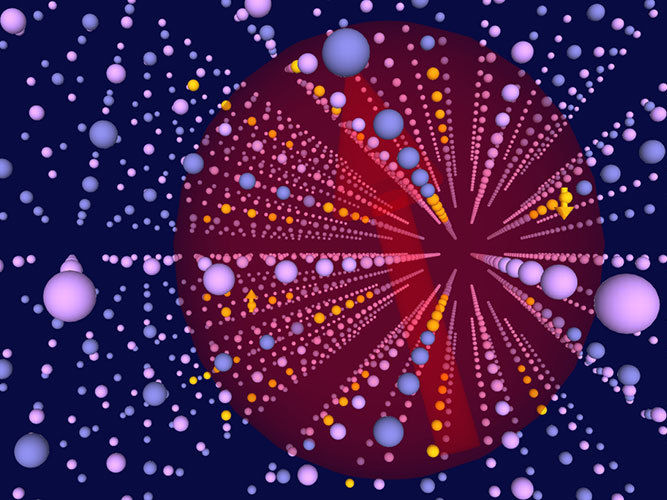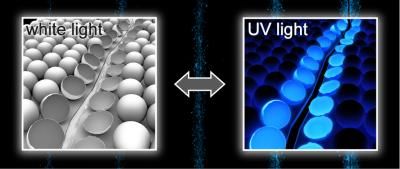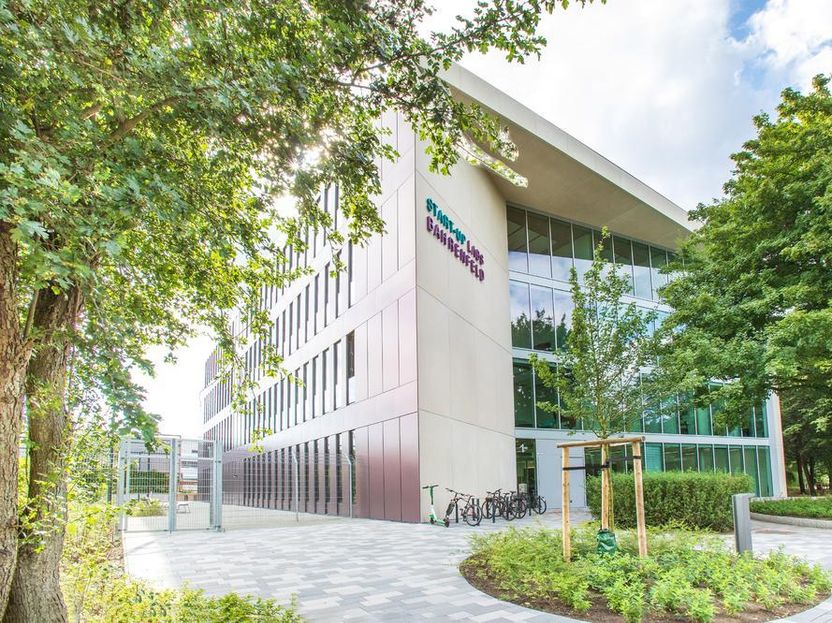Physicists Couple Distant Nuclear Spins Using a Single Electron
For the first time, researchers at the University of Basel have coupled the nuclear spins of distant atoms using just a single electron. Three research groups from the Department of physics took part in this complex experiment.

Art view of a semiconductor InAs/GaAs quantum dot (In, Ga and As respectively in yellow, blue and purple). Two remote nuclear spins (yellow arrows) are coupled via the spin of an electron delocalized over the quantum dot (red).
University of Basel, Department of Physics
In most materials, the nuclear spins of neighboring atoms have only a very weak effect on one another, as the tiny nuclei are located deep within the atoms. This is not the case in metals, however, where some of the electrons are able to move freely. The electron spins are able to couple nuclear spins at relatively large distances from one another. Named after four physicists, this RKKY interaction was discovered in the 1950s.
Nuclear spins linked by an individual electron spin
Now, an experiment by researchers from the Department of Physics at the University of Basel has for the first time succeeded in demonstrating this mechanism with a single electron, describing it using quantum theory. The team led by Prof. Richard Warburton trapped a single electron inside a quantum dot. With use of a method developed in Basel to measure nuclear spin resonance, they showed that the electron coupled the spins of nuclei up to five nanometers apart – a huge distance in the world of nuclear spins. The results are particularly relevant to the development of spin qubits: these seek to use electron spins to carry information, but the interaction with the nuclei limits the stability of the quantum information.
Concentrated blast of physics
“This is probably the most complicated experiment our team has ever carried out,” says Prof. Richard Warburton, leader of the nano-photonics research group at the Department of Physics in Basel. At the same time, he expressed his delight at the cooperation between the three research groups that made this experiment possible. “There were so many different aspects to take into account – a challenge we were able to master only thanks to the fantastic collaborations in our department.”
The research group led by Prof. Martino Poggio provided the expertise in the field of nuclear spin resonance, while the team led by Prof. Daniel Loss spent months computing the quantum theory for the experiment. A vital contribution also came from Ruhr University Bochum, which manufactured the semiconductor chips for the experiment.
Original publication
Gunter Wüst, Mathieu Munsch, Franziska Maier, Andreas V. Kuhlmann, Arne Ludwig, Andreas D. Wieck, Daniel Loss, Martino Poggio, and Richard J. Warburton; "Role of the electron spin in the nuclear spin coherence in a quantum dot"; Nature Nanotechnology; 2016
Most read news
Original publication
Gunter Wüst, Mathieu Munsch, Franziska Maier, Andreas V. Kuhlmann, Arne Ludwig, Andreas D. Wieck, Daniel Loss, Martino Poggio, and Richard J. Warburton; "Role of the electron spin in the nuclear spin coherence in a quantum dot"; Nature Nanotechnology; 2016
Organizations
Other news from the department science

Get the chemical industry in your inbox
By submitting this form you agree that LUMITOS AG will send you the newsletter(s) selected above by email. Your data will not be passed on to third parties. Your data will be stored and processed in accordance with our data protection regulations. LUMITOS may contact you by email for the purpose of advertising or market and opinion surveys. You can revoke your consent at any time without giving reasons to LUMITOS AG, Ernst-Augustin-Str. 2, 12489 Berlin, Germany or by e-mail at revoke@lumitos.com with effect for the future. In addition, each email contains a link to unsubscribe from the corresponding newsletter.
Most read news
More news from our other portals
Last viewed contents

Shining a light on damage within polymers
Claystone
Photothermal_spectroscopy
Metasediment
Greensand
Beaver_river_sandstone
Biglycan




























































